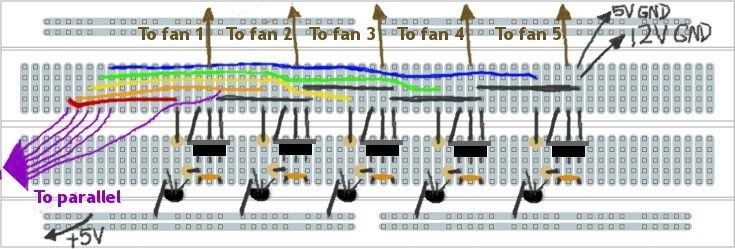
Designed, built, and documented by Christopher Mitchell
Table of Contents
1. Finished Pictures and Videos >>
2. Idea and Design >>
3. Implementation >>
1. Finished Pictures and Videos
Click any picture for a larger view
 |
 |
 |
 |
The VUfan Sound Visualization System is a visualizer of sort built of computer case fans and assorted electronics. Using five LED-lit 120mm case fans, I built a digital VU meter (volume unit meter) that provides quite a light show. It is controlled by a WinAmp plugin called DiscoLitez via the computer's parallel port; for my setup, the computer is about thirty feet from the control board and fans, so I used CAT5e wire to connect the parallel port and control board. I adjusted the sensitivity values in DiscoLitez to make the bottom fan the most sensitive and the top fan the least sensitive. Even very soft music triggers the bottom fan and lights, and the sensitivity decreases up to the top fan, which only powers on for very loud sounds and notes. I used the fans initially mainly for the bright LEDs they contain, but I later decided I liked the fan effects, particularly in the upper two fans, which aren't triggered as often as the bottom three.
The full parts list for my VUfan rig:
- Computer with parallel port. Christopher Mitchell and Cemetech disclaim any and all responsibility and liability if you manage to destroy your motherboard, your computer, yourself, or your house through your actions, following the schematics and plans on this page, or any mistakes or errors in these plans etc.
- Spare computer power supply (it is not recommended that your power this with your computer's internal power supply)
- WinAmp and the DiscoLitez Standard 2.1 plugin (available here)
- Hot glue gun with two or three sticks of hot glue.
- A breadboard, or, if you want to make it more permanent, perfboard and soldering equipment
- (5) Five TIP120 NPN power transistors (optional: heatsinks)
- (5) Five 2N3904 NPN switching transistors
- (10) Ten 1K ohm, 0.25W resistors
- (5) 0.1uF capacitors to smooth parallel port feedback
- Miscellaneous wires, wire strippers
- Five 120mm case fans with LEDs, 12v, 0.3A max recommended. I also used two additional always-on fans to cap the top and bottom of the meter. My fans looks similar to this:

I constructed the control circuit interfacing the parallel port signals to fan voltage control on a breadboard, but I plan to eventually transfer it to perfboard to make it more permenant. I originally had the parallel port directly triggering the TIP120 power transistors, but I discovered that the port could not produce enough current to trigger all five TIP120s at the same time, hence the initial stage using 2N3904 NPN switching transistors to boost the current. I also was originally sharing a power supply with a speaker, but the electrical noise generated by the fast switching of the fans was wrecking the sound quality, so I switched to a dedicated supply.
3.1 Implementation :: Hardware
Circuit Schematic:

Breadboard Layout Diagram:

» 5-Fan DiscoLitez Setup File - Load this in DiscoLitez for the same setup I have.
» WinAmp - Media player used to control the VUfan via DiscoLitez.
» DiscoLitez Standard 2.1 - WinAmp plugin to control the parallel port.
Advertisement

